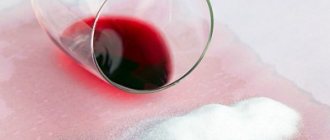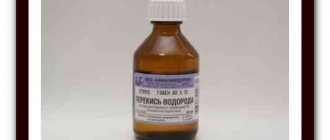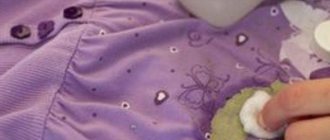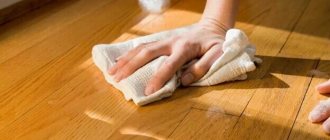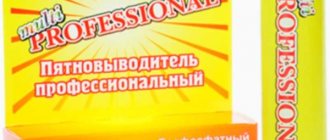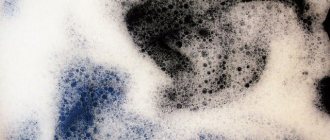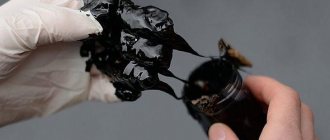Remove traces of sweat locally. Use a soap solution with shampoo or laundry soap. In its pure form, apply hydrogen peroxide, alcohol, vinegar using a cotton pad. For white fabrics, a paste of soda or a mixture of ammonia and salt is suitable.
Traces of sweat from the inside of caps and hats are removed locally using available means. To ensure that your headdress is completely clean and fresh, wash it by hand or in a machine after treatment.
WAYS TO REMOVE TRACES OF SWEAT FROM THINGS
In any case, it is important to know how to get rid of yellow spots when they appear. There are many ways that will help with this.
Using laundry soap
It is an excellent assistant in the fight against sweat stains on white. To do this, you need to wet the item and rub the contaminated areas with soap. Leave the clothes in this form for 10-15 minutes, and then rub the soapy areas with your hands. Despite the untidy appearance of laundry soap and its unpleasant smell, after washing there will be no trace of stains.
Alcohol mixture
To remove deeply ingrained yellow stains on white clothes, use a mixture of alcohols - ethyl and ammonia. Take them in equal volumes and moisten the contaminated area. Carefully wipe off the yellow marks with a sponge. After two hours they wash it. The water should be cold.
How to get rid of yellow stains when using baking soda?
First you need to prepare a soda paste. Mix a small amount of baking soda with water until a paste forms. Now apply the prepared product to the wet item and rub it a little with a brush. After this, we wash the item as usual. This method is excellent for removing stains from white clothes.
Using peroxide
This method will remove yellow sweat stains that are outdated. You need to prepare a special paste. To do this, take 2 spoons of soda, 1 spoon of gel and 30 ml of hydrogen peroxide. Mix everything thoroughly and apply to the old spot, leave for 10 minutes, then clean with a brush. If it was not possible to remove the yellowness from things in one go, then you can repeat the cleansing procedure again.
It is important to remember: after washing, it is advisable to dry the item in the shade, because if the fabric is not natural, then yellow stains will remain on it.
How to remove yellow marks with aspirin?
Aspirin is suitable for removing yellow stains from both black and white clothes.
You need to grind the tablet into powder and add a little water to make a thick mixture. Now it can be applied to the problem area, after moistening it with warm water. To achieve a good result, you need to leave the mixture on the clothes for several hours, then wash the item with powder and rinse well.
Baking soda and salt will help get rid of yellow spots
It is better to use fine salt. The same amount of soda and salt should be mixed with liquid soap, and then applied to the yellow areas under the arms. This method will definitely help get rid of the unwanted problem.
Removing yellowness using ammonia
Mix ammonia with a small amount of salt and apply to the surface of the fabric. We give it time to act so that the dirt dissolves, and then we wash the item in the usual way.
Vinegar or citric acid
Dilute 1 tsp. vinegar or citric acid with a glass of water and rub the armpits well with this solution. In order for the product to have time to dissolve the remaining sweat on the fabric, you need to give it 2-3 hours. This method is suitable for colored and white clothes, so you can safely use it. It is important to remember that if vinegar is used, then the washed item must be rinsed well several times in order to remove the pungent odor.
How to remove yellowness with vodka?
You need to rub the resulting stain with vodka, and then wash it in the usual way. Do not be alarmed if the yellowness becomes more intense at first - after washing it will be completely removed. This method is suitable for small, fresh stains, since vodka is not able to remove old stains.
Oxygen bleaches without chlorine
Specially formulated stain removers can effectively get rid of yellow spots under the arms. It is recommended to carefully study the instructions before use so as not to damage the fabric.
How to remove stains using boiling
It is worth knowing that it is only suitable for cotton fabrics. This method is great for removing old stains that cannot be removed using other methods. For boiling you will need: finely grated laundry soap, water and an aluminum boiling container. Pour the soap into water and bring to a boil, put the item with the stain in it and boil for several hours, depending on the degree of contamination.
Reviews
To verify the effectiveness of the methods disclosed in the article on how to whiten your armpits, you can additionally look at the reviews available on the Internet.
ANGELIKA, 29 YEARS OLD:
“I have heard repeatedly about the effectiveness of lemon juice as a skin whitener.
One day I decided to apply it after epilating my armpits. Indeed, my skin has brightened significantly. I started doing this every time and now after hair removal my skin tone doesn’t stand out. Now I recommend this method to all my friends.”
OLGA, 28 YEARS OLD:
“I use A'PIEU Deo Armpit Brightener.
The first time I misunderstood the instructions and simply applied the cream and washed it off after it dried. But the effect was not particularly impressive. It turned out that after application it should be rubbed into the skin for several minutes. The result was more pleasing. The skin also becomes silkier after the cream.”
ANNA, 28 YEARS OLD:
“Since my youth, I have suffered from increased sweating, which is associated with gastrointestinal disorders.
I was advised to order a roll-on crystal deodorant with turmeric from an online store. One tube lasts me for several days. I apply it constantly and there is absolutely no sweat smell. He is my salvation!
Household chemicals
To combat sweat stains on clothes, both special products and universal stain removers are useful. For each such drug, instructions are given, following which is a prerequisite for successful processing.
"HG" for removing traces of sweat and deodorant from things
This drug is developed by a company from the Netherlands. The bottle has a small volume of 0.25 liters and is equipped with a spray nozzle for ease of use. Can be used not only on white, but also on colored fabrics.
HG Sweat Stain Remover is designed to pre-treat clothes before the main wash. If the products are processed immediately, without waiting for traces of sweat to age, the effect will be greater. Silk and wool should not be used on clothing.
The disadvantages include:
- old stains cannot be removed the first time;
- specific unpleasant odor;
- high price (from 400 rubles per bottle);
- uneconomical consumption for old stains.
Vanish, stain remover and brightener “Crystal white”
A large list of Vanish TM products allows you to choose the optimal stain remover. An oxygen-containing concentrate with a volume of 0.45 liters costs from 160 rubles per bottle. The product is available in packaging of various sizes.
It can be used both to treat local stains and to pre-soak the entire item.
Advantages:
- does not contain chlorine;
- suitable for stubborn stains;
- suitable for any fabrics, including wool and silk;
- availability.
Minus: the product may not cope with old sweat stains the first time.
FINCLEAN.RU, professional stain remover
The product FINCLEAN.RU is produced in Russia. The 2 kg container has a convenient packaging with a carrying handle and a measuring cup. Can be used either separately or together with washing powder.
Advantages:
- efficiency;
- environmental friendliness;
- can be used for white and colored clothes;
- disinfects;
- oxygenating agent;
- deodorizes;
- does not irritate the skin and respiratory tract;
- restores color.
Cons: high cost - about 1,000 rubles for a 2 kg container.
What is prohibited?
Removing stains quickly and 100% can be difficult if they are old, or in cases where they were tried to be removed incorrectly. Before using one of the methods, it is necessary to analyze the type of fabric.
Chlorine
Preparations with chlorine are prohibited. Their use is not justified even for plain, snow-white products.
A substance that is aggressive in its effects can not only discolor, but also damage fabric fibers.
Heat
Items with traces of sweat that have not been washed should not be ironed - under the influence of high temperature from the soleplate of the iron, the stains will become permanent .
You should pay attention to the water heating temperature indicated in recipes; high temperatures are not always recommended.
Only cotton items can be treated with hot water, much less boiled.
Intense mechanical impact
You should also not rub the stained areas too hard . This can cause deterioration and damage to the material, as well as driving contamination deeper into the fibers.
Traditional methods of dealing with sweat stains under the armpits
Those who don’t trust store-bought products can use secrets that have been tested by more than one generation of housewives. Persistent stains from sweat can be removed using the means at hand in any household.
How to remove white spots under armpits
In order not to aggravate the situation, it is necessary to immediately wash or soak the item after wearing it, not allowing the stain to become old, which will require additional efforts to remove stains. The collection of recipes on how to remove white stains on the armpits of items made from dark or colored fabrics includes the following:
- You can remove traces of sweat from black fabric using alcohol or vodka, moistening a cotton pad and wiping the stains from the edges to the center. After waiting for a few minutes, the item should be sent for washing in an acceptable mode.
- 9% vinegar, applied to the stain and left for an hour, will help save clothes made from thin knitwear. Afterwards the product is washed by hand or in a machine.
- Colored items made from synthetic or mixed fabrics will get rid of sweat stains with a solution of vinegar and water in a ratio of 1:4. You need to soak the stain overnight and wash it in the morning.
After using each of the listed products, it is necessary to wash the product at an acceptable temperature and rinse thoroughly.
How to remove yellow armpits on white clothes
The impeccable whiteness of things indicates a person’s cleanliness, so getting rid of yellow spots is a struggle for the housewife’s reputation. Folk secrets will help you decide how to wash yellow armpits on white without damaging the fabric structure. There are helpers for this in any home.
Salt, soda, peroxide and aspirin will get rid of stains under the arms
A lot of ways to get rid of yellow spots on white wardrobe items give the housewife the opportunity to choose the appropriate option.
- Prepare a paste of baking soda and water. The paste is applied with a brush to a pre-moistened item. Applying effort, rub the mixture until the stain completely disappears, then wash it off.
- Salt and soda are mixed in equal proportions with liquid laundry soap. The resulting solution is applied to the yellowed areas. After half an hour, you can wash off the most stubborn stains.
- Hydrogen peroxide helps get rid of old yellow sweat stains in the armpits for:
- prepare a paste of 30 ml of peroxide, 2 tablespoons of baking soda, 1 tablespoon of gel or laundry soap, which is applied to the stains for 15 minutes, after which the dirt is cleaned with a brush;
- use a spray bottle to irrigate yellow spots.
- A universal remedy is aspirin, which effectively copes with stains from sweat on dark and white things. The crushed tablets are mixed with water to form a thick paste. The area pre-moistened with warm water is treated with the composition. The item is left for a couple of hours, after which it must be washed using the method indicated on the label.
- A 1:1 mixture of ammonia and salt is applied to the yellow spots, after half an hour the item is washed and rinsed.
- A solution of 1 tsp. citric acid or vinegar diluted in a glass of water is applied to the yellow spots for a couple of hours, after which washing and thorough rinsing are necessary.
- For fresh sweat stains, vodka will help by applying it to the stains and then washing the product.
- Freshly squeezed lemon juice is applied to the stains, sprinkled with salt, and after the mixture has completely dried on the fabric, the item is washed.
- Boiling can also remove sweat marks from clothing. But this option is suitable for products made of cotton fabric, where there are no synthetic impurities.
The listed methods are inexpensive but effective. Those looking for a way to remove yellow armpits on white clothes will not be disappointed with the results.
How to remove old yellow deodorant stains
Removing complex yellow stains when the deodorant has already reacted with the active substances of sweat is much more difficult, and in some situations impossible. Practical and affordable folk remedies are designed to correct the situation. Start the fight for freshness and cleanliness of clothes by resorting to the same methods as when removing fresh stains, increasing the concentration of home stain removers and repeating the procedure several times. If your efforts are unsuccessful, we offer several recipes for removing stubborn deodorant and sweat from your armpits.
Ingredients:
- Hydrogen peroxide - 4 tbsp.
- Baking soda - 2 tbsp.
- Dishwashing liquid - 1 tbsp.
How to cook:
- Mix all ingredients until smooth.
- How to use: Apply the resulting paste to the stain and leave for 2 hours. Wash and rinse the item.
- Result: The mixture dissolves the biologically active components of sweat and eliminates yellow marks from antiperspirant.
To remove deodorant stains on clothes at home, place them in a solution of ammonia and water (1 tablespoon per glass of warm water) and wait 15 minutes. For complex stains, equalize the proportions of ingredients, but reduce the duration of the procedure to 2-5 minutes. Wash things manually or in a special mode in an automatic machine.
For white cotton fabrics, the “grandmother’s” boiling method is still relevant. Boil the clothes for an hour in a five-liter saucepan, rubbing a bar of laundry soap into it, and the stubborn stain will evaporate. It is strictly forbidden to add chlorine bleaches to the water, which will damage the fabric and make stains even more noticeable. After this procedure, it is advisable to dry the washed laundry in the sun. Ultraviolet light for cotton and linen products is a get rid of such stains.
More aggressive agents include gasoline, denatured alcohol, and white spirit, which are used to soak a sponge and wipe problem areas. Use cleaning fluids after preliminary testing in compliance with safety precautions, always taking into account the type of fabric.
Useful tips
Before looking for the means in your arsenal to combat sweat stains, let's figure out what exactly you shouldn't wash off such problematic stains so as not to completely ruin the thing. Well, some useful recommendations from experts will not be superfluous:
- Never use chlorine bleach on either colored or white fabrics. The fact is that the chlorine in its composition reacts with proteins present in sweat. This may cause the fabric fibers to darken and the stain to become even more noticeable.
- Do not wash such items in hot water. It can only contribute to the consolidation of contaminants. Traces of sweat are best washed at a temperature no higher than 30 degrees.
- It is also recommended to dry washed items in the shade, rather than in the open sun or on a radiator.
- Silk products do not tolerate treatment with acetic acid and acetone, synthetics do not like gasoline and all its derivatives, cotton fabrics should not be treated with acids, and wool should not be treated with alkaline solutions.
- Acetone can discolor fabric, so do not use it to remove traces of sweat on colored clothing.
- After using hydrogen peroxide, rinse the treated clothing several times.
- Before using any product, be sure to test it on a small, inconspicuous area of clothing, preferably on the reverse side. If the fabric is discolored or deformed, it is better to choose another product.
- It is always easier to remove fresh marks than old ones, so treat stains as soon as they appear, so you have a better chance of getting rid of them 100%!
- Sweat stains appear not only from sweating, but also from the use of deodorants themselves. It is advisable to wash problem areas with laundry soap every time after using an antiperspirant. In this case, the likelihood of stains appearing will be much less.
How to remove deodorant stains from clothes
It is important not only to remove deodorant stains from dark or light clothing without a trace, but also to maintain its integrity and color. Let's consider which folk methods can resist pollution.
From white things
White clothes suffer most from the appearance of persistent yellowness. Solutions of vodka and hydrogen peroxide (1 tablespoon of the substance per 1 liter of water), in which the soiled item should be soaked for 1-2 hours, are designed to restore whiteness and eliminate unpleasant odors. The stain can be lightened well with salt and soda paste, citric acid and ammonia (1:8 with water).
Find aspirin in your medicine cabinet and wash the deodorant from your clothes after the acetylsalicylic acid has affected the stain. Dissolve two crushed tablets in a spoon of water and rub the resulting paste into the yellowish area, check the result after a couple of hours. Another option involves using aspirin in the form of a solution - 2 tablets per 100 ml of water, which should be used to moisturize the armpit area.
Why do stubborn stains form?
Sweat secretions, which contain salts and various organic substances, are mixed with antiperspirants and literally eat into the structure of the tissue. Therefore, you need to deal with stains without delay. By throwing wet clothes into the dirty laundry basket, the owner allows the formations to soak into the fabric. In this case, after a few days it will be difficult to remove traces of deodorant. It is even more difficult to eliminate yellowness by wearing the T-shirt repeatedly, for example, for training in the morning and evening without regular washing. The yellowness will stain the fabric and eat into the fibers; it will be extremely difficult to remove traces from the textile.
How to remove yellow stains from white things if they are old
It is more difficult to remove old sweat stains on white.
Lemon juice, vinegar, ammonia
Add four tablespoons of vinegar to half a liter of water and soak the clothes to be bleached for half an hour. Then mix two tablespoons of ammonia in 250 ml of warm water and pour it onto the stain. After half an hour, rinse the product and apply lemon juice diluted in the same proportions. Leave for two hours before washing.
We recommend reading: Everything you need to know to wash grass from clothes
Oxalic acid
Oxalic acid, a teaspoon of which is dissolved in 200 ml of water, will help remove old traces of sweat. The stain is generously moistened with the mixture and then washed off.
Table vinegar, soap
Table vinegar, which is moistened with the treated area for 10 minutes, will effectively remove sweat marks. Then rub with laundry soap until foam appears. After eight hours, rinse thoroughly with clean water.
Lemon acid
Before washing, apply a solution of two tablespoons of citric acid mixed in 250 ml of water to the stain.
Ammonia with white spirit
Stubborn yellowish marks will disappear if you wipe them with a mixture of ammonia and white spirit (1:1). Be sure to rinse the product thoroughly.
Gasoline and ammonia
Remove yellowness from thick white textiles with purified gasoline. They moisten the stain with it. Next apply ammonia. Wash by hand, pouring more washing powder into the water. Air dry the product.
Ammonia, alcohol, gasoline
Ammonia mixed with industrial alcohol and purified gasoline in a ratio of 2:3:4 quite reliably removes old yellowish prints without damaging the fiber structure. The mixture is soaked in the dirt five minutes before washing.
Using white spirit
If contaminants were found on silk clothes or wool, then white spirit would be the ideal option in this situation, especially if it is combined with ammonia.
The remedy against sweat marks on things should consist of white spirit and ammonia in a ratio of 4:2. If you do not maintain the ratio and use a larger percentage of ammonia, you can only provoke an increase in the area of contamination. In addition, excessive concentrations of these components provoke loss of color in clothing or damage to fabric fibers.
After preparing the composition, it must be applied with extreme caution to the area of contamination. Intense rubbing should be avoided, as the sweat will become absorbed even more. After applying the product, leave it for a period of several hours, after which it is rinsed 2-3 times in cold water.

